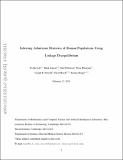Inferring Admixture Histories of Human Populations Using Linkage Disequilibrium
Author(s)
Loh, Po-Ru; Lipson, Mark; Berger, Bonnie; Patterson, Nick; Moorjani, Priya; Pickrell, Joseph K.; Reich, David; ... Show more Show less
DownloadBerger_Inferring admixture.pdf (2.232Mb)
OPEN_ACCESS_POLICY
Open Access Policy
Creative Commons Attribution-Noncommercial-Share Alike
Terms of use
Metadata
Show full item recordAbstract
Long-range migrations and the resulting admixtures between populations have been important forces shaping human genetic diversity. Most existing methods for detecting and reconstructing historical admixture events are based on allele frequency divergences or patterns of ancestry segments in chromosomes of admixed individuals. An emerging new approach harnesses the exponential decay of admixture-induced linkage disequilibrium (LD) as a function of genetic distance. Here, we comprehensively develop LD-based inference into a versatile tool for investigating admixture. We present a new weighted LD statistic that can be used to infer mixture proportions as well as dates with fewer constraints on reference populations than previous methods. We define an LD-based three-population test for admixture and identify scenarios in which it can detect admixture events that previous formal tests cannot. We further show that we can uncover phylogenetic relationships among populations by comparing weighted LD curves obtained using a suite of references. Finally, we describe several improvements to the computation and fitting of weighted LD curves that greatly increase the robustness and speed of the calculations. We implement all of these advances in a software package, ALDER, which we validate in simulations and apply to test for admixture among all populations from the Human Genome Diversity Project (HGDP), highlighting insights into the admixture history of Central African Pygmies, Sardinians, and Japanese.
Description
Author Manuscript date February 9, 2013
Date issued
2013-02Department
Massachusetts Institute of Technology. Computer Science and Artificial Intelligence Laboratory; Massachusetts Institute of Technology. Department of MathematicsJournal
Genetics
Publisher
Genetics Society of America, The
Citation
Loh, P.-R., M. Lipson, N. Patterson, P. Moorjani, J. K. Pickrell, D. Reich, and B. Berger. “Inferring Admixture Histories of Human Populations Using Linkage Disequilibrium.” Genetics 193, no. 4 (April 1, 2013): 1233-1254.
Version: Author's final manuscript
ISSN
0016-6731